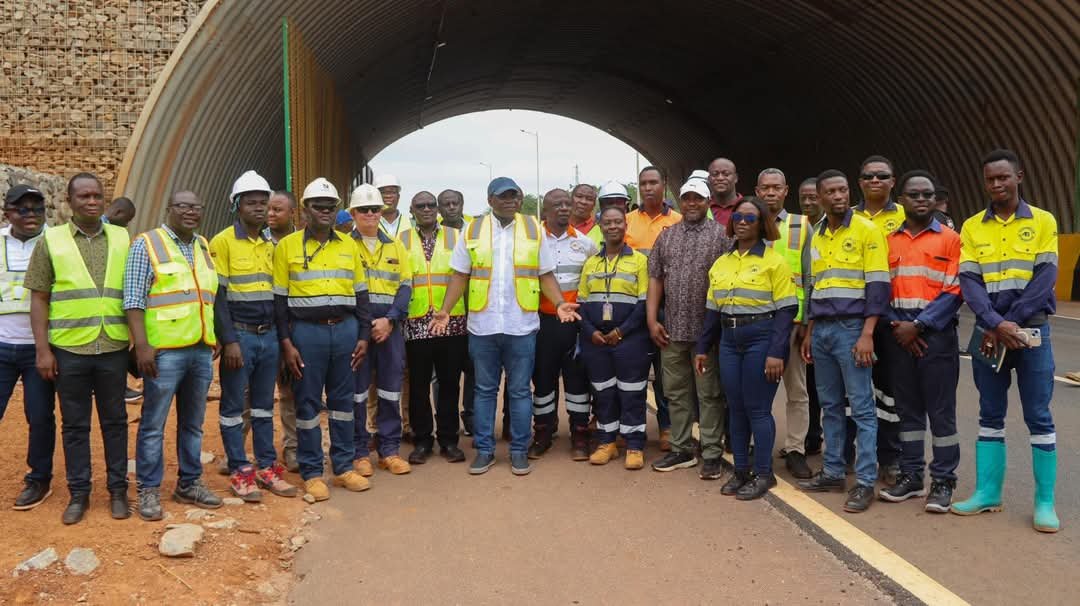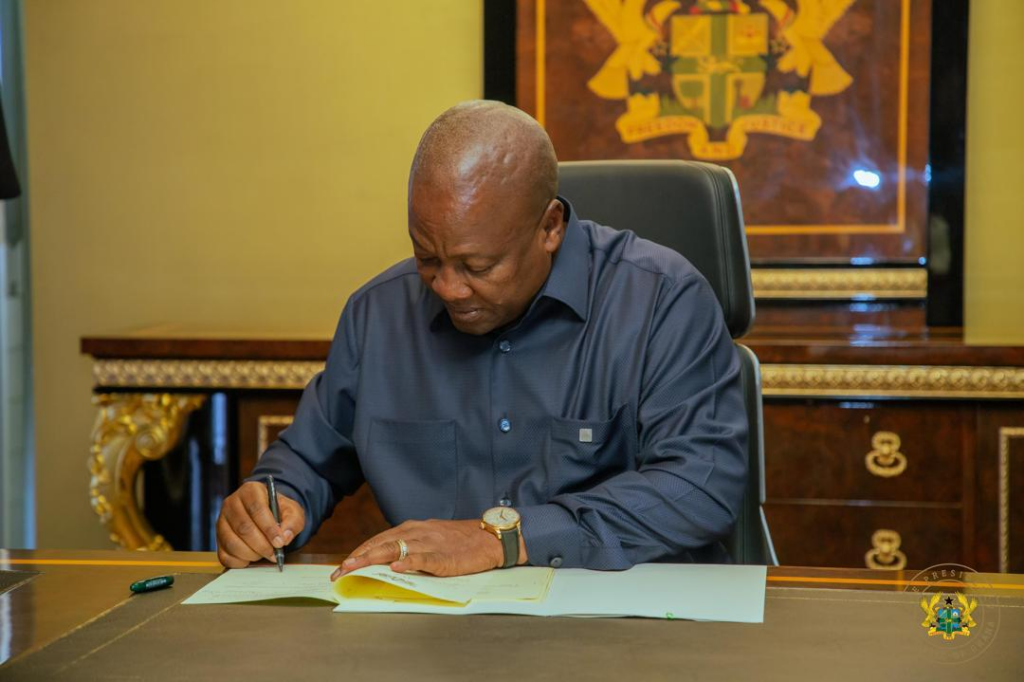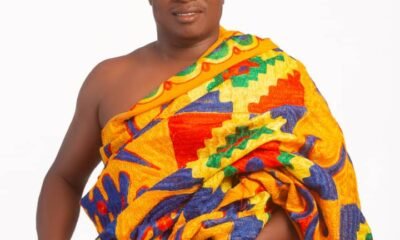News
President Akufo-Addo cuts sod for reconstruction and dualisation of Adenta-Dodowa road

The President of the Republic, Nana Addo Dankwa Akufo-Addo, as part of government’s determined pursuit to transform the road infrastructure of the nation, has on Thursday, August 8, 2024, cut the sod for the dualisation of the 22km Adentan to Dodowa road project.
Originally reconstructed in 1998, this vital inter-regional road, connects Ghana’s capital to the Eastern and Volta regions and beyond, thus forming part of government’s comprehensive strategy to enhance the main trunk roads of the country.
This comprehensive strategy also includes ongoing works on the dualization of other key roads such as the Accra-Kumasi Highway, Accra-Cape Coast road, Tema-Aflao Road and Tema Akosombo road, which are being constructed to reduce travel times, lower vehicle operating costs and significantly improve road safety.
Aside the dualization of the 22km section, the project, being undertaken by Messrs Oswald Investments Limited, an indigenous Ghanaian company, will be managed by the Ministry of Roads and Highways with the Ghana Highway Authority serving as the engineer, also includes the provision of service lanes on both lines of the main carriageway where required, provide adequate drainage structures, walkways and lay-bys along the urbanized sections.
Speaking at the well-attended sod-cutting event, which featured the Chiefs and hundreds of enthusiastic people of the area, President Akufo-Addo said this latest effort will be a welcome addition to the impressive strides by his government in the road network nationwide.
He said, some 12,830 kilometres of road have been completed nationwide.
This includes 2055 kilometres of road and the construction of four interchanges in the Greater Accra Region, in addition to the construction of three bridges in Communities 12 and 19 in Tema, as well as in Taifa.
The President added that “In addition to these completed projects, major road works are ongoing in the greater crowd region, including the dualization of the Achimota-Ofankor road, which will be expanded to a 10 lane facility with 4 interchanges at Amasaman, Pobiman, Medie and Nsawam. The project is 62% complete.”
He also mentioned the construction of the 30km Dome-Kitasi road, currently at 26% complete, the construction of the 64 km Tema Akosombo road, with sections to be dualized to six lanes and with interchanges at Ashaiman roundabout and Asutuare, which is 10% complete, the construction of the Obetsebi Lamptey Interchange Phase II, which is 87% complete, the construction of the Flower Pot Interchange across the motorway, which is 90% complete, and the dualization of the 5.7 km School Junction to Motorway road, which is 98% complete.
President Akufo-Addo also touched on the resumption of work on the construction of the Tema-Aflao road, which provides four interchanges at Kpong, Savannah, Dahwenya and Ningo Junction, the dualization of the 14.6 km Coastal road Phase I, with major bridges across the Kpeshie, Songhor, Ablekeshie street to address perennial flooding and the dualization of the 9.7 km Coastal road Phase II, Nungua to Tema, involving the construction of a 3-tier Nungua Interchange and a railway bridge towards Sakumono, which were suspended due to the debt restructuring exercise.
The President urged the contractor to implement necessary traffic management measures to minimize inconveniences to commuters in pedestriants during the construction period.
Some projects which have been completed include the iconic 4-tier Pokuase Interchange, the first of its kind in Ghana and West Africa, and the second in Africa. This project also included the construction of 12 km of local roads.
The others also include the Tema Motorway Interchange Phase One, and Obetsebi Lamptey Phase One, the dualization of Aviation Road, Otano-School Junction Road and Nana krom road, totalling 12.8km. The partial reconstruction of selected roads in Ga North, Dome-Kwabenya and Ga Central, covering 24km and the partial reconstruction of selected roads in Teshie and Nungua, covering 9 km, as well as, the surfacing of the Bobobokor area roads in Ga West, covering 25 km are all progressing steadily.
News
Reconstruction of Sunyani-Techiman-Wenchi-Wa-Hamile Road Corridor to Begin Under “Big Push” Initiative

The reconstruction of the Sunyani-Techiman-Wenchi-Wa-Hamile road corridor is set to begin in the third quarter of this year as part of the government’s “Big Push” initiative,
Kwame Agbodza, the Minister for Roads and Highways, has announced.
To this end, the Minister has directed the Ghana Highways Authority to conduct engineering studies and designs for sections of the corridor that are not currently under construction, in preparation for the upcoming work.
“This entire corridor, all the way to Hamle, is part of the ‘Big Push’ initiative. It is one of the “Big Push” projects we aim to award in June this year. Therefore, those involved in the studies and designs need to expedite their work. We don’t have enough time,” he stated.
Mr. Agbodza made these remarks this morning in Sunyani, at the start of a three-day inspection tour of the Bono, Bono East, Ahafo, and Western Regions.
The Minister indicated that government is aware of the socio-economic importance of roads towards national development, which is why road infrastructure development is being prioritized despite the financial constraints facing the country.
“No matter what we want to achieve—whether in farming, education, or healthcare—roads are critical. Our economic development cannot take shape if we do not address the challenges in the road sector,” he stressed.
Earlier, Me. Agbodza and his team of Engineers inspected the 10.20km Terchire bypass located off the Kumasi-Sunyani Highway constructed by Newmont Ghana.
During the tour, Hon. Agbodza is also expected to inspect several other road projects, including the reconstruction of the Jinijini-Sampa Road, the Tepa-Goso road, the Sefwi Wiawso town roads, the reconstruction of the Tarkwa-Agona Nkwanta road, the PTC Interchange project, and the dualization of the Takoradi-Agona Junction Road.
News
Mahama assents to Acts abolishing e-levy, betting tax and others

President John Dramani Mahama has fulfilled a key campaign promise by assenting to a set of acts that abolish the betting tax, e-Levy, and emissions tax, among others.
The signing, which has just been completed, in his office marks a major step in his administration’s efforts to reduce the financial burden on Ghanaians and drive economic growth.
The removal of these taxes was a central promise in the NDC’s manifesto aimed at easing the cost of living and encouraging business expansion.


Parliament on Wednesday, March 26, passed a bill to abolish the controversial Electronic Transfer Levy (E-Levy).
The repeal of the E-Levy has been widely welcomed by Ghanaians, who strongly opposed the tax.
The levy, which was introduced in 2022 by the previous New Patriotic Party administration, imposed a 1.5% tax on electronic transactions, including mobile money transfers, bank transfers, and online payments.
Since its introduction, there have been protests and public outcry, with critics arguing that it disproportionately affected low-income earners and the unbanked population.
Source: Myjoyonline.com
-

 News1 week ago
News1 week agoDeclaration of Monday, 31st March 2025 and Tuesday, 1st April 2025 as Public Holidays
-

 News6 days ago
News6 days agoGodfred Agbeteti is best suited to lead Kpando Municipal Assembly – Assemblyman
-

 News1 week ago
News1 week agoGEXIM CEO calls for accelerated empowerment of women in Agribusiness for Africa’s economic growth









